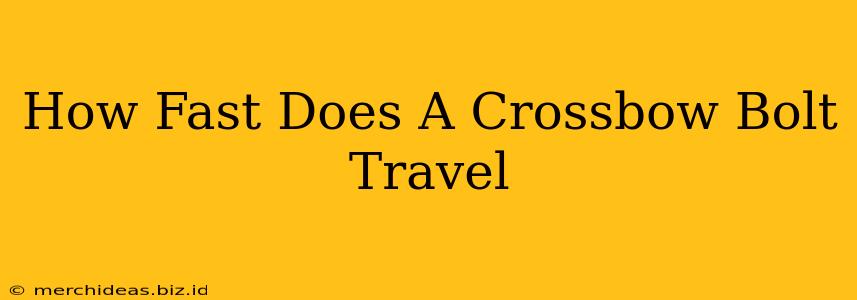Crossbows have surged in popularity, becoming a favorite for hunting, target shooting, and even recreational purposes. A key factor influencing their effectiveness and suitability for different tasks is the speed of their bolts. But how fast does a crossbow bolt travel, exactly? The answer isn't a single number; it depends on several factors. Let's delve into the specifics.
Factors Affecting Crossbow Bolt Speed
Several factors significantly impact the velocity of a crossbow bolt:
1. Draw Weight: The Primary Determinant
The draw weight is arguably the most crucial factor determining speed. This refers to the force required to pull the string back to its cocked position. Higher draw weights translate directly to more energy transferred to the bolt, resulting in higher speeds. Crossbows range from relatively low draw weights (around 125 lbs) to extremely powerful models exceeding 200 lbs. A higher draw weight generally means a faster bolt.
2. Bolt Weight: The Balancing Act
The weight of the bolt itself plays a crucial role. Lighter bolts are naturally accelerated more quickly by the same amount of energy, achieving higher speeds. However, heavier bolts possess greater kinetic energy upon impact, making them more effective for hunting larger game. Finding the right balance between speed and kinetic energy is key.
3. Bow Design and Construction: Engineering Matters
The design and construction of the crossbow itself influence bolt speed. Materials like aluminum and composite limbs contribute to efficiency and power transfer. Advanced limb designs and optimized string configurations all play a part in maximizing velocity. Modern crossbows often incorporate features like advanced cams and pulleys to enhance efficiency.
4. String and Cable Condition: Maintaining Peak Performance
The condition of the string and cables is crucial for consistent performance and optimal speed. Worn or damaged strings and cables reduce efficiency, leading to slower bolt speeds. Regular inspection and timely replacement are essential for maintaining top performance.
Typical Crossbow Bolt Speeds
While precise speeds vary greatly depending on the factors mentioned above, you can expect the following ranges:
-
Recreational Crossbows: These typically have draw weights between 125-175 lbs and achieve speeds ranging from 250 to 300 feet per second (fps).
-
Hunting Crossbows: These generally boast draw weights between 150-200+ lbs and can reach speeds of 300 to 400+ fps. Some high-powered models even exceed 400 fps.
-
High-End Crossbows: These top-of-the-line crossbows, often designed for extreme hunting or competition, can achieve speeds significantly higher than 400 fps.
Safety Considerations: Speed and Accuracy
The speed of a crossbow bolt underscores the importance of safety. Always treat a crossbow with the utmost respect, following all safety guidelines. Never point a cocked crossbow at anything you don't intend to shoot, and always wear appropriate safety gear like eye protection.
Conclusion: Understanding the Variables
The speed of a crossbow bolt is a complex interplay of several factors. Understanding these variables helps you choose the right crossbow for your specific needs and ensures you can safely and effectively utilize this powerful weapon. Whether you're choosing a recreational crossbow or a hunting model, researching the specifications, including draw weight and advertised speeds, is vital. Remember safety first!
